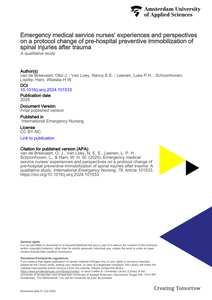Of all patients in a hospital environment, trauma patients may be particularly at risk for developing (device-related) pressure ulcers (PUs), because of their traumatic injuries, immobility, and exposure to immobilizing and medical devices. Studies on device-related PUs are scarce. With this study, the incidence and characteristics of PUs and the proportion of PUs that are related to devices in adult trauma patients with suspected spinal injury were described. From January–December 2013, 254 trauma patients were visited every 2 days for skin assessment. The overall incidence of PUs was 28⋅3% (n = 72/254 patients). The incidence of device-related PUs was 20⋅1% (n = 51), and 13% (n = 33) developed solely device-related PUs. We observed 145 PUs in total of which 60⋅7% were related to devices (88/145). Device-related PUs were detected 16 different locations on the front and back of the body. These results show that the incidence of PUs and the proportion of device-related PUs is very high in trauma patients
DOCUMENT

Background: Collar-related pressure ulcers (CRPU) are a problem in trauma patients with a suspicion of cervical cord injury patients. Indentation marks (IM), skin temperature (Tsk) and comfort could play a role in the development of CRPU. Two comparable cervical collars are the Stifneck® and Philadelphia®. However, the differences between them remain unclear. Aim: To determine and compare occurrence and severity of IM, Tsk and comfort of the Stifneck® and Philadelphia® in immobilized healthy adults. Methods: This single-blinded randomized controlled trial compared two groups of immobilized participants in supine position for 20 min. Results: All participants (n = 60) generated IM in at least one location in the observed area. Total occurrence was higher in the Stifneck®-group (n = 95 versus n = 69; p = .002). Tsk increased significantly with 1.0 °C in the Stifneck®-group and 1.3 °C in the Philadelphia®-group (p = .024). Comfort was rated 3 on a scale of 5 (p = .506). Conclusion: The occurrence of IM in both groups was high. In comparison to the Stifneck®, fewer and less severe IM were observed from the Philadelphia®. The Tsk increased significantly with both collars; however, no clinical difference in increase of Tsk between them was found. The results emphasize the need for a better design of cervical collars regarding CRPU.
LINK
ObjectiveIn 2016, a selective preventive spinal immobilization protocol for emergency medical service (EMS) nurses was introduced in the Netherlands. This protocol leaves more room for autonomous decision-making in the pre-hospital phase regarding preventive spinal immobilization (PSI), compared to the previous strict protocol. In this study, we explored the experiences and perspectives of EMS nurses on decisionmaking about PSI after the change from a strict to a selective PSI protocol. Methods: We used a qualitative design with semi-structured face-to-face interviews. Thematic analysis was applied. The capability-opportunity-motivation-behavior-model was used to interpret the experiences and perspectives. Results: Thirteen EMS nurses from three emergency medical services were interviewed. Respondents appreciated autonomous decision-making as there was more room for patient-centered informed decision-making. However, autonomous decision-making required optimized knowledge and skills and elicited the need to receive feedback on their decision not to apply PSI. When nurses anticipated resistance to selective PSI from receiving hospitals, they were doubtful to apply it. Conclusion: Nurses appreciate the increased autonomy in decision-making, encouraging them to focus on patient-centered care. Increased autonomy also places higher demands on knowledge and skills, calling for training and feedback. Anticipated resistance to receiving hospitals based on mutual protocol discrepancies could lead to PSI application by EMS nurses while not deemed necessary. Recommendations: To enhance PSI procedures, optimizing the knowledge and skills of EMS nurses that facilitate on-scene decision-making may be indicated. A learning loop for feedback between the EMS nurses and the involved hospitals may add to their professional performance. More efforts are needed to create support for the changed Emergency Medical Services strategy in PSI to prevent unnecessary PSI and practice variation.
DOCUMENT
